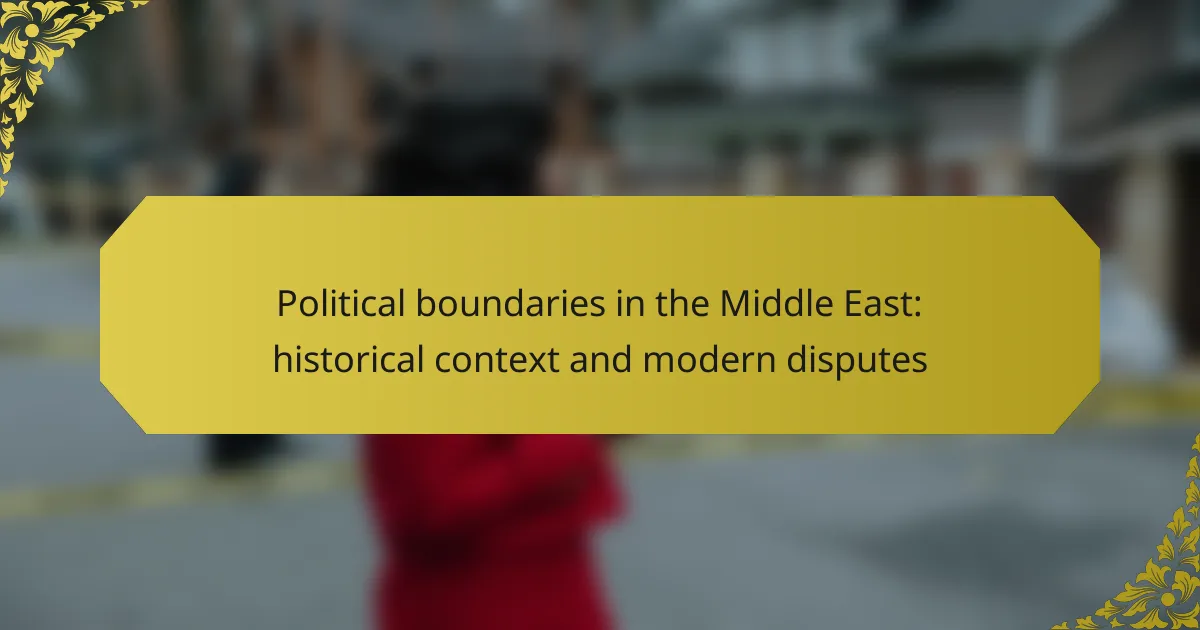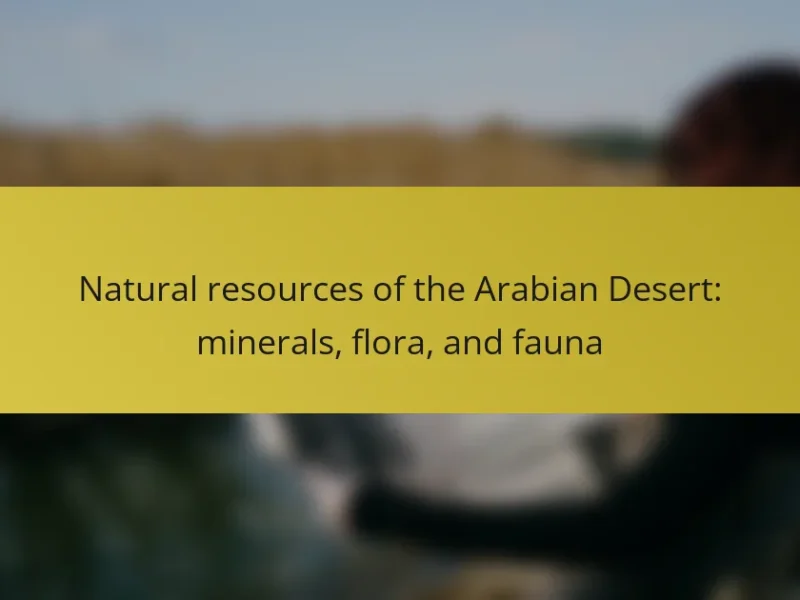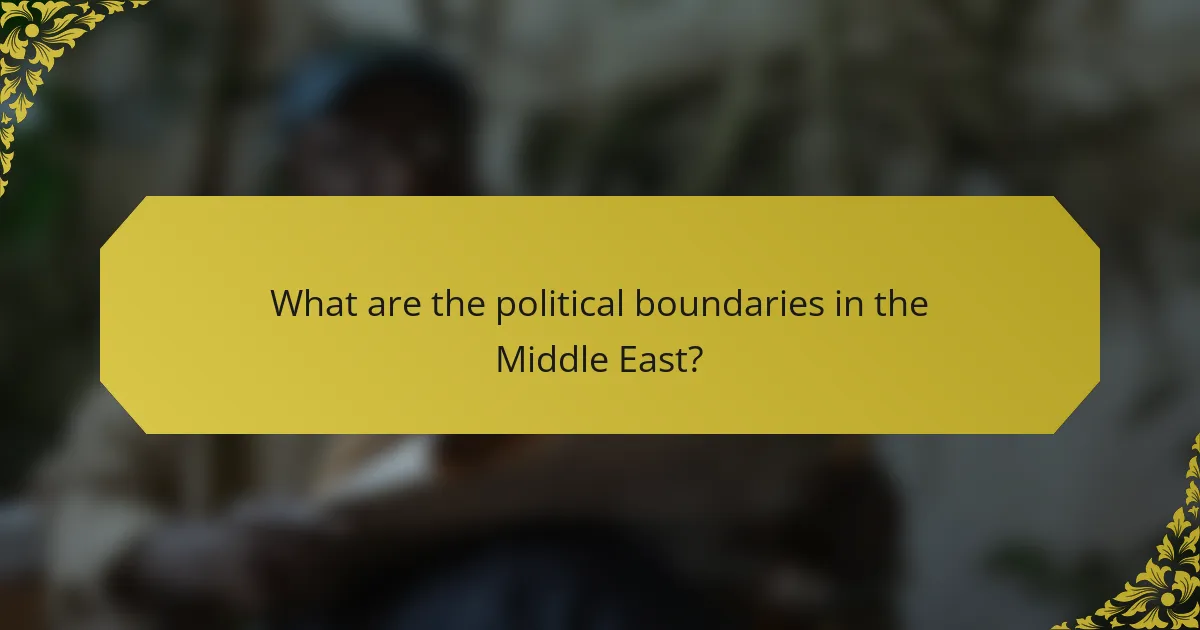
What are the political boundaries in the Middle East?
The political boundaries in the Middle East are defined by the borders of sovereign states formed through historical treaties, conflicts, and colonial legacies. Key countries include Israel, Saudi Arabia, Iran, Iraq, Syria, and Turkey. The Sykes-Picot Agreement of 1916 significantly influenced these boundaries, dividing Ottoman territories. The borders often reflect ethnic, religious, and cultural divisions, leading to ongoing disputes. For example, the Israel-Palestine conflict arises from contested claims over territory. Additionally, the Syrian civil war has created shifting boundaries with the rise of various factions. The political landscape remains dynamic, with borders subject to change due to geopolitical tensions and conflicts.
How have historical events shaped these political boundaries?
Historical events have significantly influenced the political boundaries in the Middle East. The collapse of the Ottoman Empire after World War I led to the creation of new nation-states. The Sykes-Picot Agreement of 1916 established borders that often disregarded ethnic and religious divisions. The establishment of Israel in 1948 resulted in ongoing conflicts and territorial disputes. The Arab-Israeli wars further altered boundaries and created refugee crises. Additionally, colonial legacies and international interventions have shaped current political landscapes. These events demonstrate how history has directly impacted the formation and evolution of political boundaries in the region.
What major treaties and agreements influenced boundary formations?
The major treaties and agreements that influenced boundary formations in the Middle East include the Sykes-Picot Agreement, the Balfour Declaration, and the Treaty of Sèvres. The Sykes-Picot Agreement, signed in 1916, divided the Ottoman Empire’s territories between Britain and France. The Balfour Declaration, issued in 1917, expressed British support for a Jewish homeland in Palestine. The Treaty of Sèvres, signed in 1920, formalized the partitioning of the Ottoman Empire. These agreements laid the groundwork for modern state boundaries in the region. They often disregarded ethnic and religious divisions, leading to ongoing disputes.
How did colonialism impact the political landscape of the Middle East?
Colonialism significantly reshaped the political landscape of the Middle East. It led to the arbitrary drawing of national borders by colonial powers. These borders often ignored ethnic, tribal, and religious lines. Consequently, this created tensions and conflicts among different groups. The Sykes-Picot Agreement of 1916 exemplifies this division. It divided the region between British and French control without local input. Colonial rule also established centralized governments that did not reflect local governance traditions. This resulted in political instability in many countries post-independence. Overall, colonialism’s legacy continues to influence modern political disputes in the region.
What role do ethnic and religious groups play in defining these boundaries?
Ethnic and religious groups significantly influence the definition of political boundaries in the Middle East. These groups often share common cultural, historical, and linguistic traits. Their identities shape national aspirations and territorial claims. For instance, the Kurds seek autonomy across Turkey, Iraq, and Iran based on ethnic identity. Similarly, religious sects such as Sunni and Shia Muslims impact governance and territorial divisions. Historical events, like the Sykes-Picot Agreement, further solidified boundaries that did not consider these identities. Consequently, conflicts often arise when boundaries ignore ethnic and religious affiliations. This dynamic complicates peace efforts and regional stability.
How do ethnic tensions affect border disputes in the region?
Ethnic tensions significantly exacerbate border disputes in the region. These tensions often stem from historical grievances, cultural differences, and competition for resources. For example, in areas where multiple ethnic groups coexist, claims to territory can lead to conflict. Disputes over land often arise when one group feels marginalized or threatened by another. The presence of ethnic minorities can complicate negotiations over borders. In many cases, national governments may exploit these tensions to consolidate power or distract from internal issues. Historical events, such as the division of Ottoman territories, have left a legacy of unresolved ethnic conflicts. These factors create a volatile environment where border disputes are frequent and often violent.
What is the significance of religious sites in territorial claims?
Religious sites hold significant importance in territorial claims due to their cultural and historical value. These sites often symbolize identity and heritage for specific groups. Control over these areas can enhance a group’s legitimacy in territorial disputes. For example, the Western Wall in Jerusalem is a focal point for Jewish claims to the city. Similarly, the Al-Aqsa Mosque is central to Palestinian claims. The presence of sacred sites can intensify conflicts, as they are seen as non-negotiable by the communities involved. Historical events, such as the Crusades, highlight how religious significance has shaped territorial ambitions. Therefore, religious sites are not merely landmarks; they are pivotal in the political landscape of territorial claims.
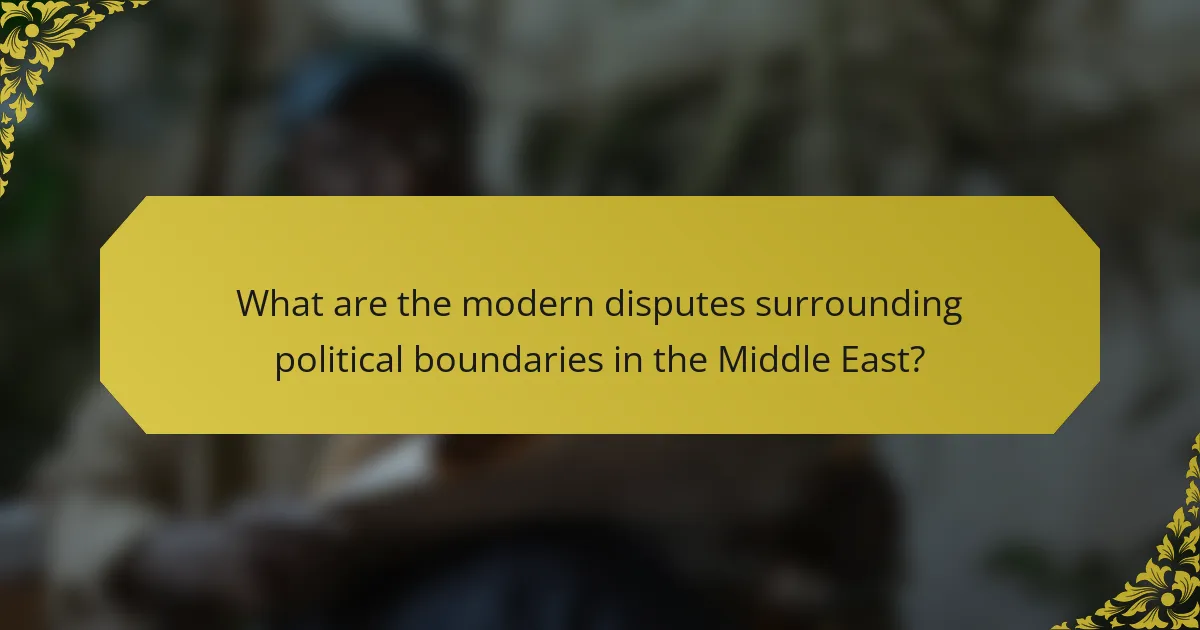
What are the modern disputes surrounding political boundaries in the Middle East?
Modern disputes surrounding political boundaries in the Middle East include territorial conflicts and national identity issues. The Israeli-Palestinian conflict is a prominent example, with disputes over land claims and sovereignty. The Syrian civil war has also led to contested borders, particularly with Kurdish groups seeking autonomy. Iraq faces challenges with the Kurdish region’s push for independence, complicating national cohesion. Additionally, the ongoing tensions between Iran and Saudi Arabia influence boundary disputes, particularly in Yemen. These conflicts often stem from historical agreements, such as the Sykes-Picot Agreement, which drew arbitrary borders. The lack of resolution in these disputes contributes to ongoing instability in the region.
What are the key conflicts related to political boundaries today?
Key conflicts related to political boundaries today include territorial disputes, ethnic tensions, and resource allocation. In the Middle East, the Israeli-Palestinian conflict exemplifies a major territorial dispute over land claimed by both groups. The Kurds seek independence and autonomy across Iraq, Turkey, Syria, and Iran, leading to ethnic tensions and conflict. Additionally, conflicts arise over water resources, such as the Nile and Tigris rivers, impacting regional stability. Historical agreements, like the Sykes-Picot Agreement, have also contributed to ongoing disputes. These conflicts are often exacerbated by foreign intervention and geopolitical interests.
How do current geopolitical interests influence these disputes?
Current geopolitical interests significantly influence disputes in the Middle East. Nations often prioritize strategic alliances and resource control. For instance, oil reserves attract foreign involvement, shaping territorial claims. Regional powers seek to expand influence through proxy conflicts. The U.S. and Russia have vested interests in supporting different factions. Historical agreements, like the Sykes-Picot Agreement, still resonate today. These agreements often disregarded ethnic and sectarian divisions, fueling tensions. Consequently, geopolitical interests exacerbate existing conflicts and create new disputes.
What are the implications of these disputes for regional stability?
Disputes over political boundaries in the Middle East significantly undermine regional stability. These conflicts often lead to increased tensions among neighboring countries. For instance, territorial disputes can escalate into military confrontations. Historical grievances fuel animosities, making diplomatic resolutions challenging. Additionally, such disputes can create power vacuums, inviting external interventions. The Syrian civil war exemplifies how boundary disputes can destabilize an entire region. Instability in one country frequently spills over into adjacent nations, resulting in refugee crises and economic strain. Ultimately, unresolved disputes perpetuate cycles of violence and hinder development efforts across the region.
How do international organizations address boundary disputes in the Middle East?
International organizations address boundary disputes in the Middle East through diplomatic mediation and conflict resolution efforts. Organizations such as the United Nations facilitate negotiations between conflicting parties. They provide frameworks for dialogue and peace talks, often involving third-party mediators. International organizations also deploy peacekeeping missions to stabilize regions experiencing conflict. They monitor ceasefires and help implement agreements. Additionally, these organizations may offer legal advice regarding international law and territorial claims. Historical context, such as the Sykes-Picot Agreement, influences current boundary disputes. The effectiveness of these efforts varies, depending on the willingness of parties to engage in dialogue.
What role do the United Nations and other bodies play in mediating conflicts?
The United Nations and other bodies play a crucial role in mediating conflicts. They facilitate dialogue between conflicting parties. The UN employs peacekeeping missions to maintain stability. These missions often include military and civilian personnel. Additionally, the UN provides a platform for negotiations. This includes hosting peace talks and drafting resolutions. Historical examples include the UN’s involvement in the Arab-Israeli conflict. The UN Security Council has passed numerous resolutions addressing this issue. Other organizations, like the African Union, also engage in mediation efforts. Their involvement often leads to ceasefires and peace agreements.
How effective have peacekeeping missions been in the region?
Peacekeeping missions in the region have had mixed effectiveness. Some missions have successfully reduced violence and fostered dialogue. For instance, the United Nations Interim Force in Lebanon (UNIFIL) has helped maintain peace since 1978. However, other missions have faced challenges and limitations. The effectiveness of peacekeeping can be hindered by local political dynamics and lack of cooperation from conflicting parties. In some cases, peacekeepers have been unable to prevent escalations in violence. Thus, the overall impact varies significantly based on the specific context of each mission.
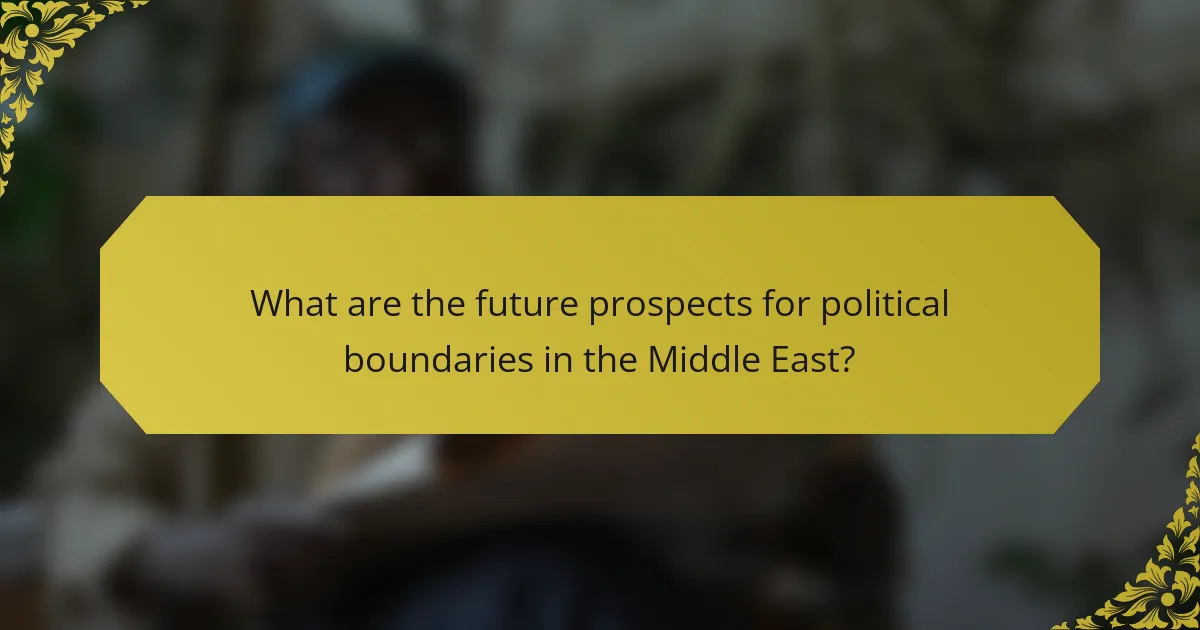
What are the future prospects for political boundaries in the Middle East?
The future prospects for political boundaries in the Middle East are uncertain and complex. Ongoing conflicts and territorial disputes shape these boundaries. For instance, the Syrian civil war has altered regional dynamics and influenced borders. The rise of non-state actors, like ISIS, has further complicated territorial integrity. Additionally, external influences from global powers impact boundary negotiations. Historical agreements, such as the Sykes-Picot Agreement, still resonate in contemporary politics. National identities and ethnic divisions also play crucial roles in boundary discussions. Therefore, future political boundaries may evolve based on conflict resolution, diplomacy, and demographic changes.
How might shifts in power dynamics affect these boundaries?
Shifts in power dynamics can significantly alter political boundaries in the Middle East. Changes in leadership, such as revolutions or regime changes, often lead to redefined territorial claims. For instance, the Arab Spring resulted in new governance structures and altered alliances. These shifts can incite conflicts over borders, as seen in the Syrian civil war, where various factions vie for territorial control. Additionally, external influences, such as foreign interventions, can reshape boundaries by supporting certain groups. Historical treaties, like the Sykes-Picot Agreement, illustrate how power dynamics have historically defined borders. Thus, as power balances shift, so too do the boundaries that define political landscapes.
What emerging trends could reshape the political landscape?
Emerging trends that could reshape the political landscape include the rise of populism, increased digital activism, and shifting geopolitical alliances. Populism has gained traction in many countries, often leading to significant changes in governance and policy. Digital activism allows grassroots movements to mobilize quickly and effectively, influencing political discourse and decision-making. Additionally, shifting geopolitical alliances, particularly in the Middle East, are altering traditional power dynamics. For example, the normalization of relations between Israel and several Arab states has changed the regional political landscape. These trends are interconnected and can lead to both opportunities and challenges for future governance.
How does public opinion influence boundary negotiations?
Public opinion significantly influences boundary negotiations by shaping the political landscape and decision-making processes. When citizens express strong views on territorial issues, governments often feel pressured to align with these sentiments. This is particularly evident in the Middle East, where public opinion can mobilize protests or support for specific territorial claims. For instance, in the Israeli-Palestinian conflict, public sentiment has historically affected negotiations and peace talks. Surveys have shown that shifts in public opinion can lead to changes in government policy regarding land disputes. Additionally, media coverage of public opinion can amplify certain narratives, impacting the negotiation dynamics.
What strategies can be employed to resolve ongoing disputes?
Negotiation, mediation, and arbitration are effective strategies to resolve ongoing disputes. Negotiation involves direct discussions between conflicting parties to reach a mutually acceptable agreement. Mediation introduces a neutral third party to facilitate dialogue and help find common ground. Arbitration involves a binding decision made by an impartial arbitrator after hearing both sides. These strategies have been used in various historical contexts, such as the Camp David Accords in 1978, which successfully negotiated peace between Egypt and Israel. Research indicates that collaborative approaches often lead to more sustainable resolutions in complex disputes.
What best practices have been successful in other regions?
It is not possible to provide a definitive answer to the question about best practices in other regions regarding political boundaries in the Middle East. The complexities of historical contexts and modern disputes vary greatly across different regions. Each region has unique circumstances that influence the effectiveness of any political practice. Therefore, generalizing best practices may not yield applicable solutions for the Middle East.
How can dialogue and diplomacy pave the way for lasting solutions?
Dialogue and diplomacy can pave the way for lasting solutions by fostering communication and understanding among conflicting parties. Effective dialogue allows stakeholders to express their needs and concerns. Diplomacy facilitates negotiations that can lead to mutually acceptable agreements. Historical examples, such as the Camp David Accords in 1978, illustrate how dialogue can resolve long-standing disputes. The Accords led to a peace treaty between Egypt and Israel, demonstrating the potential of diplomatic efforts. In addition, continuous dialogue can build trust over time, reducing the likelihood of future conflicts. Ultimately, diplomacy creates a framework for cooperation and conflict resolution.
The main entity of the article is the political boundaries in the Middle East, shaped by historical events, treaties, and ongoing disputes. The article examines how colonial legacies, such as the Sykes-Picot Agreement, have influenced the formation of these borders and the resulting ethnic and religious tensions. It highlights key conflicts, including the Israeli-Palestinian dispute and the Syrian civil war, while discussing the role of international organizations in mediating these issues. Additionally, the article explores the implications of current geopolitical interests and emerging trends on regional stability and future boundary negotiations.
